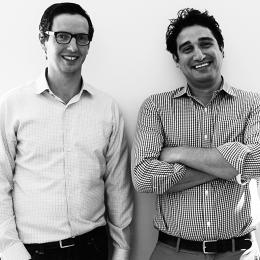Marketing
 Let’s face it — U.S. marketers spent nearly $60 billion in 2015 on digital ads, but the industry doesn’t do a great job connecting people with products they want. According to Christophe Primault, CEO of GetApp, just 10% of consumers find what they’re looking for when interacting with online content.
Let’s face it — U.S. marketers spent nearly $60 billion in 2015 on digital ads, but the industry doesn’t do a great job connecting people with products they want. According to Christophe Primault, CEO of GetApp, just 10% of consumers find what they’re looking for when interacting with online content.
The key to relevant messaging lies with data, but the challenge is no longer collecting it. Each day, we create 2.5 quintillion bytes of data. Today’s challenge is using data to deliver customers more contextual, personalized impressions.
Imagine a world where programs execute optimized, data-driven campaigns tailored to each consumer. No longer will “audience” refer to nebulous demographic swaths. Soon, every digital ad you see will be tailored to a very specific audience — you.
The Silicon Valley giants that gave us social networks, smartphones, and apps have realized the power of those tools to capture the customer data required for hypertargeted marketing.
Twitter, for example, recently launched Brand Hub, an analytics tool for large advertisers and medium-sized companies. It enables businesses to monitor brand-related tweets, measure their share of conversations relative to competitors, and automatically classify customers’ tweets.
While marketers want to track customers’ brand sentiments on social media, the tool’s real power is that it enables companies to hypertarget by viewing top influencers in the conversation. Brand Hub lists phrases being tweeted and estimates brand loyalty implied by tweets, enabling marketers to personalize messaging according to users’ online behavior.
If your company isn’t eligible for Twitter’s Brand Hub, don’t fear. There are other techniques your company can use to make your marketing more personalized.
1. Get (more) social. Once you’ve qualified a high-quality lead, it’s tempting to make the sale and move on. But don’t view a high-value customer as the end game. Instead, realize he’s the tip of a valuable iceberg: his social networks.
If you were a professional photographer, you’d consider a woman searching for wedding photographers to be a target customer. The key is to step back and look at her family and friends, too.
First, offer discounts to encourage her to like or follow your brand on social media. Once you can view the customer’s profile, investigate her online connections. Are her friends getting married? Would family members want to take a family portrait? Contact connections and — this is key — mention your shared connection to provide social proof. Simply mentioning a mutual connection can increase conversions by up to 468%.
2. Try account-based marketing software. ABM software is another effective way to hypertarget marketing efforts. ABM treats accounts as separate marketing opportunities and tailors digital messaging accordingly. For example, my company uses ABM to deliver personalized ads based on search queries. Somebody who searches “land contract” will be targeted with a message reading, “Create your land contract today.”
3. Consider the bigger picture. This is all about critical thinking. Let’s say a consumer searched “calculus textbooks” before leaving Amazon. Rather than remarketing those textbooks to the customer – usually by showing him ads for them all over the web – Amazon might instead assume he’d bought them elsewhere, and instead consider complementary products like graphing calculators or tutoring guides.
Spotify personalizes ads based on consumers’ interests and demographic data. If somebody listens to a “Morning Run” playlist, Spotify might deliver ads for running shoes or athletic apparel. By monitoring a person’s Spotify activity, the streaming service can categorize leads with great specificity: cat owners aged 40 to 45 in a big city; beer drinkers in Kansas; young, African-American men who bicycle.
4. Use geo-targeting. Nearly two-thirds of American adults now own smartphones. As a result, brands can tap into users’ locations to market everything from nearby fast food to industry-specific software.
Geo-targeting is particularly useful for industry conferences, a concentrated source of leads. If you can’t attend, use geo-targeting to market to attendees without leaving your office. Buy mobile ads in the city — or in a specific block — where a conference is held. Then, use ABM software to tailor messages for each lead.
At my company, we create ads based on leads’ IP addresses. To market lease agreements, for instance, we consider a user’s city (e.g., “Create your Phoenix lease agreement!”). We further adjust messaging based on time of day and seasonality.
It’s incredible how far marketing has come in recent decades. Not long ago, marketers would buy a newspaper ad or billboard, then hope for the best.
Today, we can’t predict exactly who will buy what and when, but we’re getting closer. The industry has begun a radical transformation — one where marketing dollars will be better spent, ads will speak directly to us, and brands will intuit our every need.
Making Personalized Marketing Work
February 29, 2016

The key to relevant messaging lies with data, but the challenge is no longer collecting it. Each day, we create 2.5 quintillion bytes of data. Today’s challenge is using data to deliver customers more contextual, personalized impressions.
Imagine a world where programs execute optimized, data-driven campaigns tailored to each consumer. No longer will “audience” refer to nebulous demographic swaths. Soon, every digital ad you see will be tailored to a very specific audience — you.
The Silicon Valley giants that gave us social networks, smartphones, and apps have realized the power of those tools to capture the customer data required for hypertargeted marketing.
Twitter, for example, recently launched Brand Hub, an analytics tool for large advertisers and medium-sized companies. It enables businesses to monitor brand-related tweets, measure their share of conversations relative to competitors, and automatically classify customers’ tweets.
Insight Center
The Global Digital Economy
Sponsored by Accenture
Strategies for growth in a connected world.
If your company isn’t eligible for Twitter’s Brand Hub, don’t fear. There are other techniques your company can use to make your marketing more personalized.
1. Get (more) social. Once you’ve qualified a high-quality lead, it’s tempting to make the sale and move on. But don’t view a high-value customer as the end game. Instead, realize he’s the tip of a valuable iceberg: his social networks.
If you were a professional photographer, you’d consider a woman searching for wedding photographers to be a target customer. The key is to step back and look at her family and friends, too.
First, offer discounts to encourage her to like or follow your brand on social media. Once you can view the customer’s profile, investigate her online connections. Are her friends getting married? Would family members want to take a family portrait? Contact connections and — this is key — mention your shared connection to provide social proof. Simply mentioning a mutual connection can increase conversions by up to 468%.
2. Try account-based marketing software. ABM software is another effective way to hypertarget marketing efforts. ABM treats accounts as separate marketing opportunities and tailors digital messaging accordingly. For example, my company uses ABM to deliver personalized ads based on search queries. Somebody who searches “land contract” will be targeted with a message reading, “Create your land contract today.”
While ABM was once a tool for enterprise brands with a few highly valuable accounts, big data has made ABM useful to companies of all sizes. One digital company I know increased page views by 300% and pipeline growth by 22% with ABM software.
Spotify personalizes ads based on consumers’ interests and demographic data. If somebody listens to a “Morning Run” playlist, Spotify might deliver ads for running shoes or athletic apparel. By monitoring a person’s Spotify activity, the streaming service can categorize leads with great specificity: cat owners aged 40 to 45 in a big city; beer drinkers in Kansas; young, African-American men who bicycle.
4. Use geo-targeting. Nearly two-thirds of American adults now own smartphones. As a result, brands can tap into users’ locations to market everything from nearby fast food to industry-specific software.
Geo-targeting is particularly useful for industry conferences, a concentrated source of leads. If you can’t attend, use geo-targeting to market to attendees without leaving your office. Buy mobile ads in the city — or in a specific block — where a conference is held. Then, use ABM software to tailor messages for each lead.
At my company, we create ads based on leads’ IP addresses. To market lease agreements, for instance, we consider a user’s city (e.g., “Create your Phoenix lease agreement!”). We further adjust messaging based on time of day and seasonality.
It’s incredible how far marketing has come in recent decades. Not long ago, marketers would buy a newspaper ad or billboard, then hope for the best.
Today, we can’t predict exactly who will buy what and when, but we’re getting closer. The industry has begun a radical transformation — one where marketing dollars will be better spent, ads will speak directly to us, and brands will intuit our every need.




















